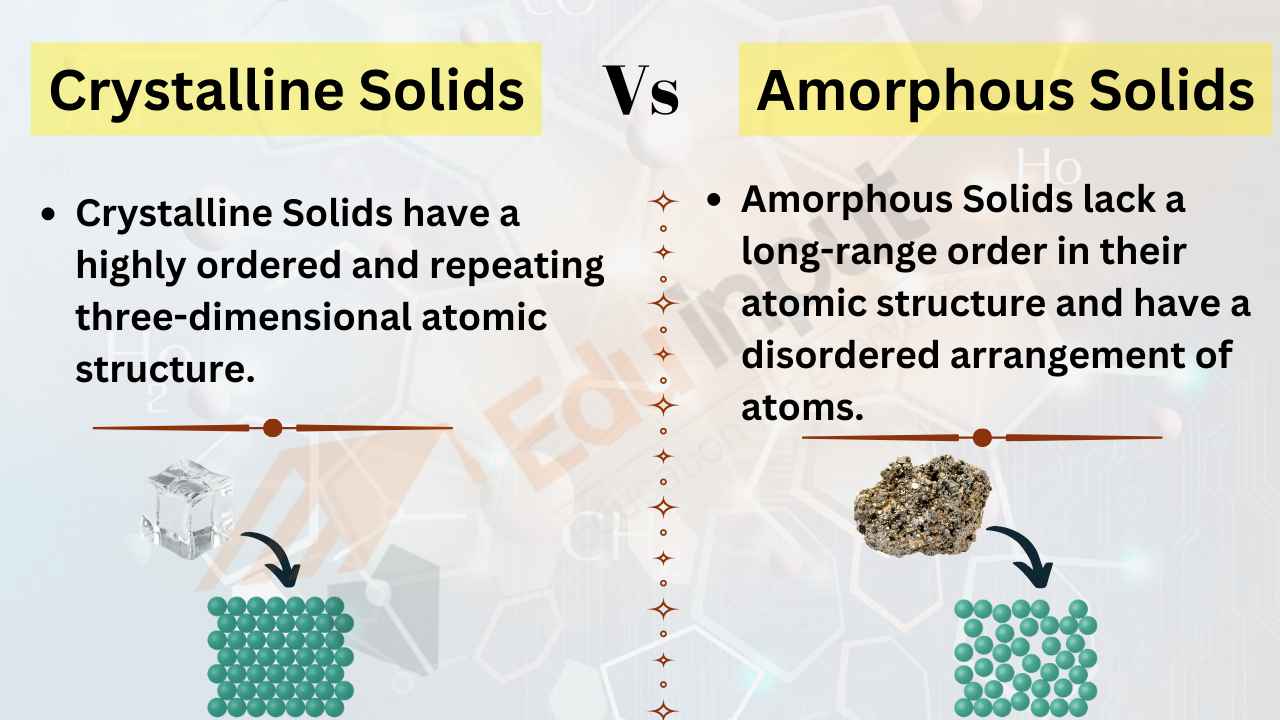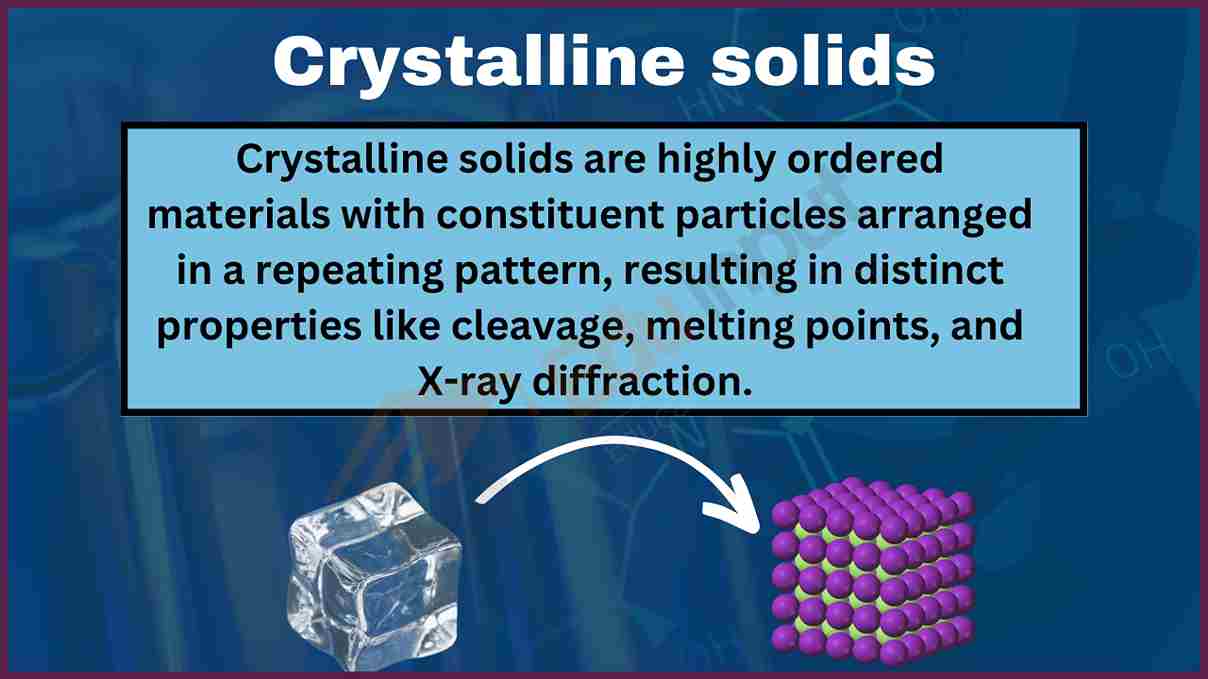Solids: Definition, Properties, Types, Applications
What is solid?
Solids are one of the three states of matter, which have a definite shape and volume, and their molecules are closely packed together. This article will explore the various characteristics of solids, including their types, crystal structures, and properties.
Properties of Solids
Solids are one of the three states of matter, along with liquids and gases. They have a definite shape and volume and are characterized by their physical properties. Here are some of the key properties of solids:
Definite shape
Solids have a fixed shape, meaning that they maintain their shape and size under normal conditions. The particles that make up a solid are tightly packed and held together by strong intermolecular forces.
Definite volume
Solids have a fixed volume, meaning that they occupy a specific amount of space. This is due to the strong intermolecular forces that hold the particles together.
Density
Solids have a high density, meaning that they are relatively heavy for their size. This is because the particles are packed tightly together, and there is little space between them.
Hardness
Solids can be hard or soft, depending on the strength of their intermolecular forces. Hard solids have strong intermolecular forces that make them difficult to break or deform, while soft solids have weaker intermolecular forces that make them easier to deform.
Melting point
Solids have a specific melting point, which is the temperature at which they transition from a solid to a liquid state. This is due to the breaking of the intermolecular forces that hold the particles together.
Conductivity
Solids can be either conductors or insulators, depending on their chemical composition. Metals, for example, are good conductors of electricity, while most nonmetals are insulators.
Brittleness
Some solids are brittle, meaning that they are prone to breaking or cracking under stress. This is due to the arrangement of their particles and the strength of their intermolecular forces.
Classification of solids
Solids can be classified into different types based on their structural characteristics. Here are some common types of solids based on their structure:
1: Crystalline Solids
Crystalline solids have a highly ordered and repeating atomic or molecular structure. Examples include salt, diamonds, and quartz. Crystalline solids have distinct properties such as high melting and boiling points, and they can be easily characterized by X-ray diffraction.
2: Amorphous Solids
Amorphous solids lack a regular, ordered structure. Examples include glass, rubber, and plastic. Amorphous solids have random arrangements of atoms or molecules and typically have lower melting and boiling points than crystalline solids.
3: Polycrystalline Solids
These are solids that are made up of many small crystals or grains that are randomly oriented. Examples include most metals and ceramics. Polycrystalline solids have properties that are intermediate between those of single crystals and amorphous solids.
Types of Solids
In chemistry, solids are a state of matter that has a fixed shape and volume and are characterized by their strong intermolecular forces. However, not all solids are created equal. Different types of solids exhibit unique properties, structures, and behaviors.
1: Ionic Solids
Ionic solids are composed of positively and negatively charged ions that are held together by electrostatic forces. These solids have a high melting and boiling point, are brittle, and are typically insoluble in organic solvents. Examples of ionic solids include sodium chloride (NaCl), calcium fluoride (CaF2), and potassium bromide (KBr).
2: Molecular Solids
Molecular solids are composed of discrete molecules that are held together by intermolecular forces such as dipole-dipole interactions, hydrogen bonding, and van der Waals forces. These solids have a low melting and boiling point, are generally soft, and can be either soluble or insoluble in organic solvents. Examples of molecular solids include ice (H2O), solid carbon dioxide (CO2), and sulfur (S8).
3: Metallic Solids
Metallic solids are composed of metal atoms that are held together by metallic bonds. These solids have a high melting and boiling point, are typically hard and ductile, and are good conductors of heat and electricity. Examples of metallic solids include copper (Cu), iron (Fe), and gold (Au).
4: Covalent Network Solids
Covalent network solids are composed of atoms that are held together by strong covalent bonds in a three-dimensional network structure. These solids have a high melting and boiling point, are typically hard and brittle, and are poor conductors of heat and electricity. Examples of covalent network solids include diamond (C), silicon dioxide (SiO2), and graphite (C).
Crystal Structures
Solids can have different crystal structures, which are determined by the arrangement of their atoms or molecules. The most common crystal structures are the cubic, tetragonal, orthorhombic, rhombohedral, monoclinic, and triclinic structures. Each of these structures has its own unique properties and characteristics.
Applications of solids
Solids are used in multiple ways in daily life. The following are the most common uses of solids.
1: Construction Materials
Solid materials such as concrete, bricks, and stones are commonly used in construction. They are used for building foundations, walls, and floors. These materials are preferred for their strength, durability, and stability. Additionally, they can withstand natural disasters such as earthquakes and hurricanes.
2: Jewelry
Precious metals such as gold, silver, and platinum are used to create beautiful and intricate jewelry pieces. These metals are valued for their aesthetic appeal and rarity. They are often used to make rings, necklaces, bracelets, and earrings.
3: Furniture
Solid wood, metal, and plastic are used to create furniture such as chairs, tables, and sofas. These materials offer strength, durability, and style. Additionally, they can be customized to fit a particular design or aesthetic.
4: Packaging
Solid materials like cardboard, plastic, and metal are used to create packaging materials for a wide range of products. These materials offer protection for the products during shipping and storage. Additionally, they can be printed with branding and other information.
5: Tools
Solid metals like steel and iron are used to create a variety of tools like hammers, saws, and screwdrivers. These materials offer strength and durability. Additionally, they can be shaped and sharpened to perform specific tasks.
6: Automotive Industry
Solid materials like steel, aluminum, and plastic are used extensively in the manufacturing of automobiles. They are used for the body frame, engine components, and other parts. These materials offer strength, durability, and efficiency.
7: Electronics
Solid-state electronics, such as semiconductors and transistors, are crucial components of modern electronic devices like computers, smartphones, and televisions. These materials offer high performance, reliability, and speed.
8: Medical Devices
Solid materials like titanium and stainless steel are used to create surgical implants, joint replacements, and other medical devices. These materials offer biocompatibility, strength, and durability. Additionally, they can be customized to fit a patient’s specific needs.
9: Sports Equipment
Solid materials like metal, plastic, and composite materials are used to create a variety of sports equipment like golf clubs, tennis rackets, and hockey sticks. These materials offer strength, durability, and performance. Additionally, they can be customized to fit a particular player’s needs.
10: Art and Sculpture
Solid materials like marble, bronze, and clay are used by artists and sculptors to create beautiful works of art that are admired around the world. These materials offer durability, versatility, and aesthetic appeal. Additionally, they can be shaped and carved to create intricate details and textures.
Faqs
What are solids?
Solids are one of the three states of matter, along with liquids and gases. They have a definite shape and volume, and their molecules are closely packed together.
What are the different types of solids?
There are four main types of solids: molecular solids, covalent network solids, ionic solids, and metallic solids. Each type has its own unique properties and characteristics.
What determines the crystal structure of a solid?
The crystal structure of a solid is determined by the arrangement of its atoms or molecules. Different types of solids have different crystal structures, which can be determined through X-ray crystallography.
How do the properties of solids vary between different types?
The properties of solids can vary greatly depending on their composition and structure. For example, metallic solids are good conductors of electricity, while covalent network solids are generally very hard and have high melting points.
What are some real-world applications of solids?
Solids have many practical applications in fields such as construction, medicine, electronics, and engineering. For example, steel is a commonly used solid in construction, while silicone is used in medical implants.
How do solids differ from liquids and gases?
Solids have a fixed shape and volume, while liquids have a fixed volume but can take the shape of their container, and gases have neither a fixed shape nor volume.
Can solids be compressed or expanded?
Solids can be compressed or expanded to some degree, but their compressibility and expansibility are generally much lower than that of liquids or gases.
How are solids classified based on their bond type?
Solids can be classified based on the type of bond between their atoms or molecules. For example, molecular solids have intermolecular forces holding their molecules together, while covalent network solids have covalent bonds between their atoms.
What factors affect the melting and boiling points of solids?
The melting and boiling points of solids depend on a variety of factors, including their composition, crystal structure, and intermolecular forces. Solids with strong intermolecular forces or covalent bonds tend to have higher melting and boiling points.
How do scientists study the properties of solids?
Scientists use a variety of techniques to study the properties of solids, including X-ray crystallography, electron microscopy, and thermal analysis. These techniques help to determine the crystal structure, composition, and physical properties of solids.






Leave a Reply